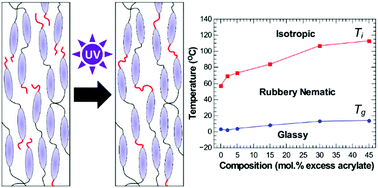当前位置:
X-MOL 学术
›
Soft Matter
›
论文详情
Our official English website, www.x-mol.net, welcomes your feedback! (Note: you will need to create a separate account there.)
Thermomechanical properties of monodomain nematic main-chain liquid crystal elastomers†
Soft Matter ( IF 3.4 ) Pub Date : 2018-06-20 00:00:00 , DOI: 10.1039/c8sm01178h Daniel R. Merkel 1, 2, 3, 4 , Nicholas A. Traugutt 2, 4, 5, 6 , Rayshan Visvanathan 4, 7, 8, 9 , Christopher M. Yakacki 2, 4, 5, 6 , Carl P. Frick 1, 2, 3, 4
Soft Matter ( IF 3.4 ) Pub Date : 2018-06-20 00:00:00 , DOI: 10.1039/c8sm01178h Daniel R. Merkel 1, 2, 3, 4 , Nicholas A. Traugutt 2, 4, 5, 6 , Rayshan Visvanathan 4, 7, 8, 9 , Christopher M. Yakacki 2, 4, 5, 6 , Carl P. Frick 1, 2, 3, 4
Affiliation

|
Two-stage thiol-acrylate Michael addition reactions have proven useful in programming main-chain liquid crystal elastomers (LCEs). However, the influence of excess acrylate concentration, which is critical to monodomain programming, has not previously been examined with respect to thermomechanical properties in these two-stage LCEs. Previous studies of thiol-acrylate LCEs have focused on polydomain LCEs and/or variation of thiol crosslinking monomers or linear thiol monomers. This study guides the design of monodomain LCE actuators using the two-stage methodology by varying the concentration of mesogenic acrylate monomers from 2 mol% to 45 mol% in stoichiometric excess of thiol. The findings demonstrate a technique to tailor the isotropic transition temperature by 44 °C using identical starting monomers. In contrast to expectations, low amounts of excess acrylate showed excellent fixity (90.4 ± 2.9%), while high amounts of excess acrylate did not hinder actuation strain (87.3 ± 2.3%). Tensile stress–strain properties were influenced by excess acrylate. Linear elastic behavior was observed parallel to the director with modulus increasing from 1.4 to 6.1 MPa. The soft elastic plateau was observed perpendicular to the director with initial modulus and threshold stresses increasing from 0.6 MPa to 2.6 MPa and 14 kPa to 208 kPa, respectively. Overall, this study examines the influence of excess acrylate on mechanical properties of LCE actuators.
中文翻译:

单畴向列主链液晶弹性体的热力学性能†
已证明两级硫醇丙烯酸酯的迈克尔加成反应可用于对主链液晶弹性体(LCE)进行编程。但是,对于单域编程至关重要的过量丙烯酸酯浓度的影响,以前尚未针对这些两阶段LCE中的热机械性能进行过研究。硫醇丙烯酸酯LCE的先前研究集中于多结构域LCE和/或硫醇交联单体或线性硫醇单体的变化。这项研究通过在化学计量过量的硫醇中将介晶丙烯酸酯单体的浓度从2 mol%更改为45 mol%,指导了使用两阶段方法的单畴LCE致动器的设计。这些发现证明了使用相同的起始单体在44°C下调整各向同性转变温度的技术。与期望相反,少量的过量丙烯酸酯显示出优异的固着性(90.4±2.9%),而大量的过量丙烯酸酯则不会阻碍致动应变(87.3±2.3%)。拉伸应力-应变性能受过量丙烯酸酯的影响。观察到平行于指向矢的线性弹性行为,其模量从1.4 MPa增加到6.1 MPa。垂直于导向器观察到软弹性平台,初始模量和阈值应力分别从0.6 MPa增加到2.6 MPa和14 kPa增加到208 kPa。总的来说,本研究考察了过量丙烯酸酯对LCE执行器机械性能的影响。观察到平行于导向器的线性弹性行为,其模量从1.4 MPa增加到6.1 MPa。垂直于导向器观察到软弹性平台,初始模量和阈值应力分别从0.6 MPa增加到2.6 MPa和14 kPa增加到208 kPa。总的来说,本研究考察了过量丙烯酸酯对LCE执行器机械性能的影响。观察到平行于导向器的线性弹性行为,其模量从1.4 MPa增加到6.1 MPa。垂直于导向器观察到软弹性平台,初始模量和阈值应力分别从0.6 MPa增加到2.6 MPa和14 kPa增加到208 kPa。总的来说,本研究考察了过量丙烯酸酯对LCE执行器机械性能的影响。
更新日期:2018-06-20
中文翻译:

单畴向列主链液晶弹性体的热力学性能†
已证明两级硫醇丙烯酸酯的迈克尔加成反应可用于对主链液晶弹性体(LCE)进行编程。但是,对于单域编程至关重要的过量丙烯酸酯浓度的影响,以前尚未针对这些两阶段LCE中的热机械性能进行过研究。硫醇丙烯酸酯LCE的先前研究集中于多结构域LCE和/或硫醇交联单体或线性硫醇单体的变化。这项研究通过在化学计量过量的硫醇中将介晶丙烯酸酯单体的浓度从2 mol%更改为45 mol%,指导了使用两阶段方法的单畴LCE致动器的设计。这些发现证明了使用相同的起始单体在44°C下调整各向同性转变温度的技术。与期望相反,少量的过量丙烯酸酯显示出优异的固着性(90.4±2.9%),而大量的过量丙烯酸酯则不会阻碍致动应变(87.3±2.3%)。拉伸应力-应变性能受过量丙烯酸酯的影响。观察到平行于指向矢的线性弹性行为,其模量从1.4 MPa增加到6.1 MPa。垂直于导向器观察到软弹性平台,初始模量和阈值应力分别从0.6 MPa增加到2.6 MPa和14 kPa增加到208 kPa。总的来说,本研究考察了过量丙烯酸酯对LCE执行器机械性能的影响。观察到平行于导向器的线性弹性行为,其模量从1.4 MPa增加到6.1 MPa。垂直于导向器观察到软弹性平台,初始模量和阈值应力分别从0.6 MPa增加到2.6 MPa和14 kPa增加到208 kPa。总的来说,本研究考察了过量丙烯酸酯对LCE执行器机械性能的影响。观察到平行于导向器的线性弹性行为,其模量从1.4 MPa增加到6.1 MPa。垂直于导向器观察到软弹性平台,初始模量和阈值应力分别从0.6 MPa增加到2.6 MPa和14 kPa增加到208 kPa。总的来说,本研究考察了过量丙烯酸酯对LCE执行器机械性能的影响。



























 京公网安备 11010802027423号
京公网安备 11010802027423号